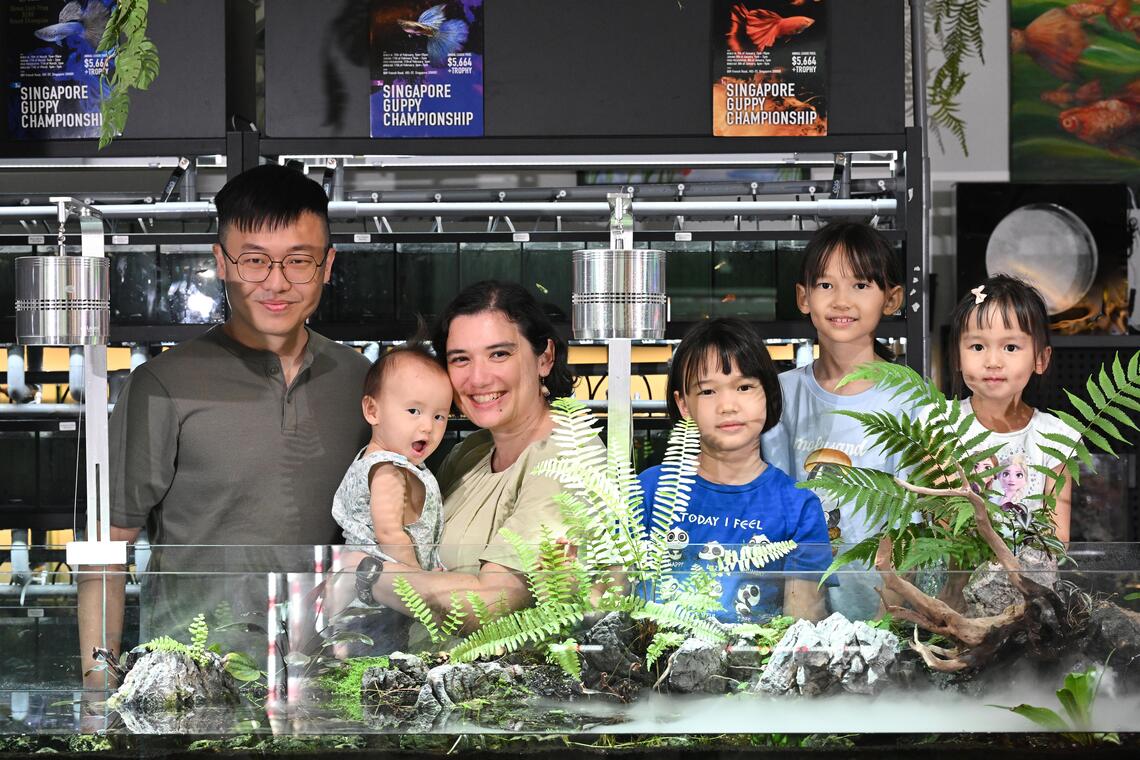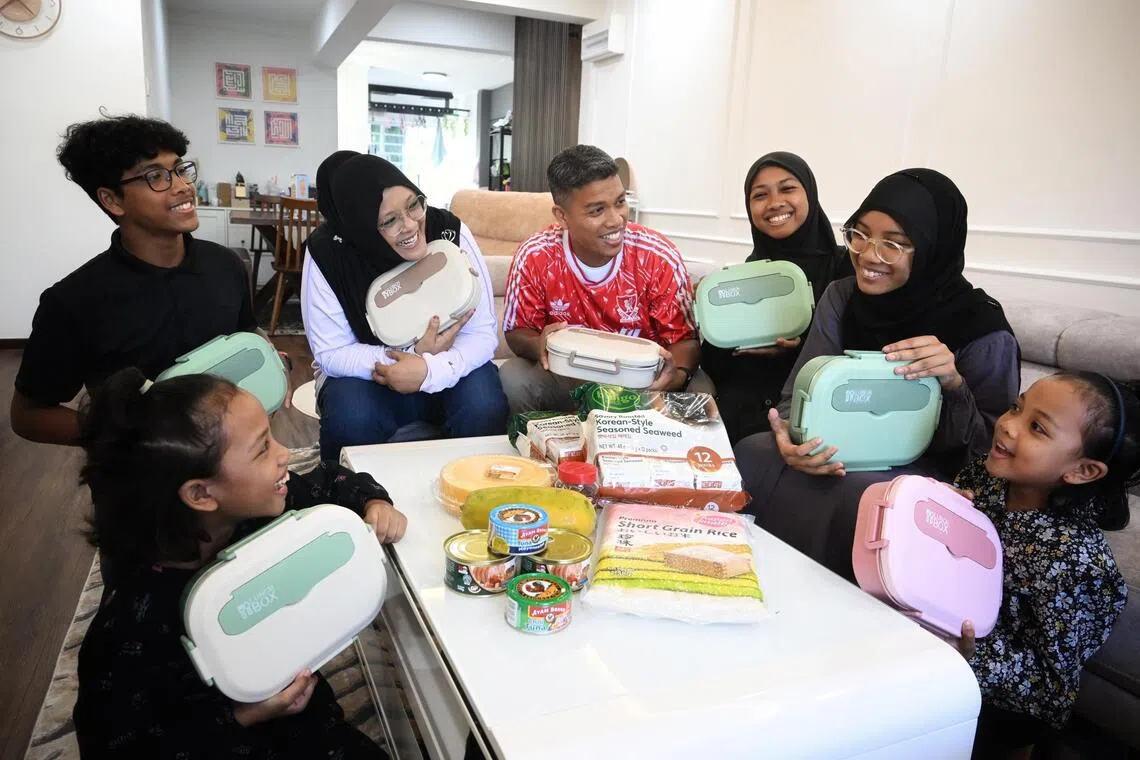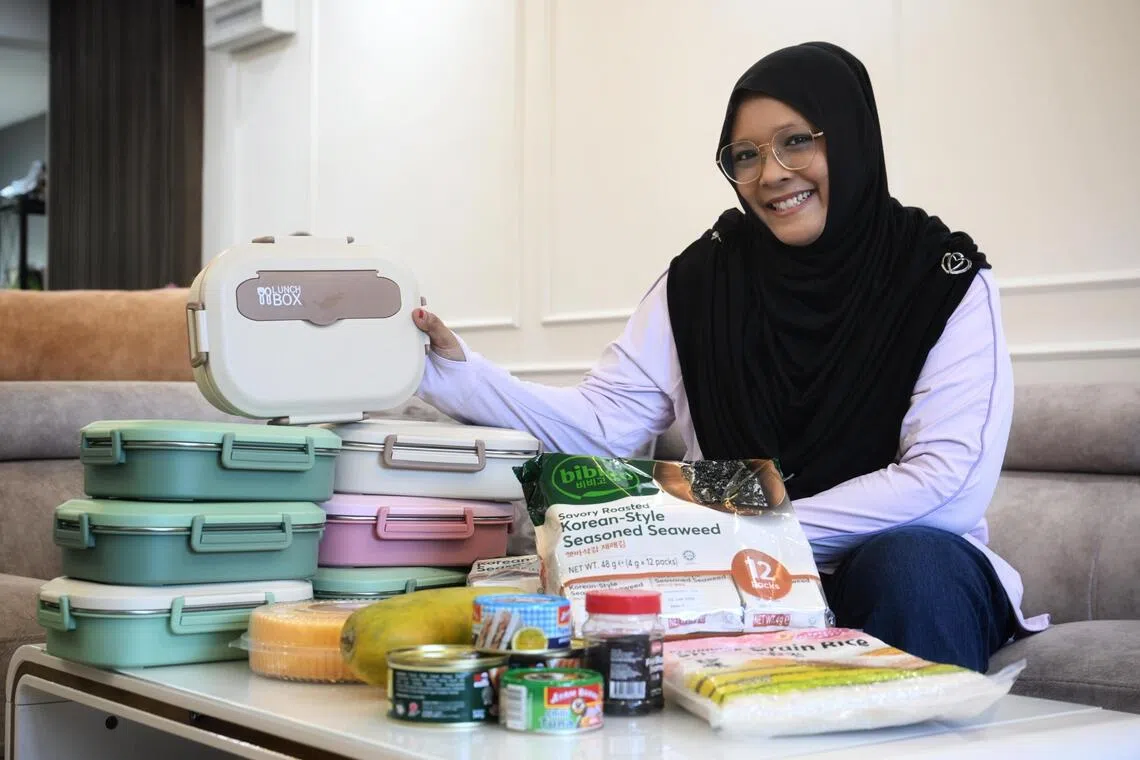7 ways that big families in Singapore can get big savings
Sign up now: Get ST's newsletters delivered to your inbox

Jonathan Poh and his wife, Selena Vera Hey, with their four daughters, Naomi (second from right), Natalie (third from right), Natasha (extreme right), and Nadya, at his shop in Kitchener Complex on Sept 6.
ST PHOTO: LIM YAOHUI
Follow topic:
- Singaporean families with three or more young children receive $1,000 credits per child under the Large Families Scheme to help with expenses, as announced by MSF.
- Families are adopting strategies like bulk-buying, using hand-me-downs, and comparing prices to cut costs, creating an "ecosystem" of savings, according to parent Ms Selena Hey
- Large Families Deals initiative offers discounts on essentials and activities via Families for Life; FairPrice offers doubled CHAS discounts until December 2025.
AI generated
SINGAPORE – Ms Selena Hey and the other adults in her household have been whittling down a stockpile of more than 40 big tubes of toothpaste, which she estimates will last about three years.
Her four children use a different, fruit-flavoured children’s toothpaste, which she bought in packs of six.
Bulk-buying and stocking up on household items – such as toothpaste, diapers, milk powder and detergent – during sales to last for up to three years is par for the course when it comes to cutting costs for her large family.
Ms Hey, a 41-year-old teacher, and her husband Jonathan Poh, 42, owner of Nature Therapy Studio, which designs aquariums and terrariums, have four daughters aged nine, seven, four and one.
Their eight-member household includes her mother and domestic helper, and they live in a five-room Housing Board flat in Sengkang.
From Sept 10, families with three or more Singaporean children started to receive $1,000 in credits for each third and subsequent child, aged one to six, under a scheme to defray expenses.
This was the first disbursement under the Large Families Scheme, introduced by Prime Minister Lawrence Wong at Budget 2025. These Large Family LifeSG credits, valid for 12 months, are credited to the government mobile app LifeSG ( www.life.gov.sg/app
Parents can also tap the Large Families Deals initiative curated by the Families for Life movement. More than 50 organisations such as FairPrice and Tada are now offering deals on diapers and other household staples, as well as savings on bookings of large-capacity rides with ride-hailing apps.
But even before these, comparing prices across supermarkets, choosing cheaper house brands, using hand-me-downs and signing up for membership cards have been common practices, say large families interviewed by The Straits Times.
“We try to cut costs in all areas. It’s an ecosystem,” says Ms Hey.
She plumps for air-conditioning in dry mode at home, which lowers the humidity and uses less energy; her monthly mobile phone plan is basic, costing around $9; and her helper cuts her daughters’ hair to save on hairdressing costs.
Here are seven budgeting tips that could save money for families big and small.
1. Hack online shopping
Ms Hey, a permanent resident from Malaysia, leverages her family’s Johor connections to save money. Her retired 67-year-old mother still has a home in Johor Bahru, which she rents out.
Ms Hey takes advantage of the favourable currency exchange rate, where S$1 is equivalent to RM3.26, to order essential items like formula milk and diapers online.
By changing the specified country from Singapore to Malaysia in the settings on the Lazada shopping app, she buys non-perishable goods at around one-third of the price, and gets them delivered to her mum’s house in Malaysia. A family member will make his or her way to Johor every two months or so to collect the items.
She also saves on shopping in other ways. For instance, by opting to go to a designated collection point to pick up purchases she orders on the Shopee app, rather than getting the items delivered to her home, she is not charged delivery fees.

Ms Hey, a permanent resident from Malaysia, leverages her family’s Johor connections to save money. Her retired 67-year-old mother still has a home in Johor Bahru, which she rents out.
ST PHOTO: LIM YAOHUI
2. Rethink tuition
Instead of conventional tuition, which can cost $100 or more a session, she pays around $20 a month each for her older daughters, Naomi, nine, and Natalie, seven, to do online learning programme KooBits in subjects like mathematics.
To save on transport costs, Naomi and Natalie attend a primary school that is a five-minute walk from home, while four-year-old Natasha attends pre-school at My First Skool below their HDB flat. “We don’t need to travel by car or bus to any of the children’s school or enrichment activities, which saves time and money,” says Ms Hey.
3. Live simply
“We’re not into branded stuff. We’re both quite simple people, except when indulging in bubble tea,” says Ms Hey, who treats herself to the occasional honey oolong milk tea.
She buys only two-ply toilet paper for the household instead of thicker variations that are more expensive. They eat mostly at home and limit family holidays to regional destinations like Malaysia.
4. Embrace sustainability
Hand-me-downs are a given, with Ms Hey herself using dresses passed down from a sister-in-law.
“Almost everything” is second-hand, bought on online marketplace Carousell or received from friends and family, she says. This includes the children’s clothes, toys, shoes, strollers, school uniforms and scooters.
Ms Hey gets “bags of books” from her teacher colleagues and still uses her hospital-issued diaper bag.
A big portable bathtub, bought from Chinese online shopping platform Taobao, was only recently relinquished, after having served all four children.
Her Singaporean husband, Mr Poh, says: “We are very practical and open to using second-hand items. I was the only grandchild to accept free bowls and cutlery from my late grandmother.”
Ten years after they got married and moved into their resale flat, they still use mismatched crockery, scoured from pasar malams (night markets), which his grandma urged on them at the time. Some sport designs like goldfish or children playing sports, while others came free with Ribena drinks and other sundries years ago.
A spirit of thrift and sustainability runs in both families. Mr Poh’s father once salvaged a discarded high chair that converts into a cot. The piece, found beneath their apartment block, was cleaned, fixed and upcycled for the children’s use.
“I married into the right family,” says Ms Hey with a grin.
5. Compare prices and wait
Mr Poh reckons he saved at least $30,000 when he and his wife renovated their flat in 2015.
He acted as interior designer and project manager, directly engaging tradesmen like contractors, carpenters and electricians, spending a total of about $30,000 compared with quotations of $60,000 to $90,000 from interior design firms.
For instance, he was quoted $4,000 for new window grilles, but sourced them himself for $800. He took his time, doing further research to get more competitive prices. “Always get at least three comparative quotes and do not be too quick to commit,” he says.
The couple chose to honeymoon in Bali and Bangkok in part because they could source for cheaper household furnishings there – such as a large clock and mirror – for their new home.
6. Meal prep for the whole family
Other large families suggest that the household’s approach towards food is the key to staying under budget.
Mother-of-five Shahida Suratman, 42, prepares meals and snacks for her children, aged 17, 15, 13, nine and seven, her husband, a 43-year-old prison officer, and herself every school day.
These typically comprise a lunch of pasta, noodles, rice or sandwiches, with protein, fruit and dessert, such as aglio olio pasta with prawns, asparagus, a small bunch of grapes and a slice of chiffon cake. The children eat the dessert during snack break in school.
Ms Shahida, a care adviser at Malay/Muslim self-help group Yayasan Mendaki, wakes around 4.45am during term time to make food for her family of seven, some of which is cooked the night before.

Ms Shahida (third from left) and her husband, Ahmad Saifullah (centre, in red) with their children (clockwise from left) Adriana Syuhada, Aniq Syahin, Amirah Sofya, Alisha Syaistah and Afiah Sumayyah showing their lunch boxes and some of the food items ready for preparation on Sept 21.
ST PHOTO: CHONG JUN LIANG
7. Instil family values
While meal prep saves money, Ms Shahida also uses it as a way to inculcate family values and encourage financial literacy. The children take turns to plan the family menu ahead of time, which encourages a sense of autonomy and teamwork. The menu is fixed a week before the term begins, to allow time for grocery shopping.
Ms Shahida says: “Everyone takes ownership to prepare the menu. They also have to consider what their siblings eat and don’t eat, and how to prevent wastage.”
While the children do not have to spend money buying food at school, the primary schoolers get $3 a day, while the older ones get $5 a day for pocket money.
Ms Shahida says: “I’m trying to encourage them to save and distinguish between wants and needs. It’s important to discuss as a family how to spend. It’s also about being comfortable with what you have.”

Ms Shahida with food items ahead of the food preparation and seven lunch boxes for her husband and five children on Sept 21.
ST PHOTO: CHONG JUN LIANG
Savings for large families
Here are some Large Families Deals, curated by Families for Life, available for parents of three children and more who may be looking to cut costs. More information can be found at go.gov.sg/lfs-deals
1. Cooking lessons at ABC Cooking Studio
New members enjoy a special membership rate of $72 each, compared with the usual price of $144.
Info: str.sg/n6C5
2. Swimming lessons at Happy Fish Swim School
Families enrolling at least three students, across various age groups, get 15 per cent off one full term’s fees for group classes. Different fees apply.
Info: str.sg/eKRc
3. Fun rides at Sentosa 4D AdventureLand
Check out 4D rides, virtual reality games and interactive activities at this Sentosa theme park. Tickets for two adults and three children cost $166, achieving savings of $44.50 from original prices.
Info: str.sg/BUFo
4. Shopee discounts
Top up Large Families LifeSG credits into ShopeePay on Shopee for deals such as 20 per cent off weekly vouchers, bundled deals of up to 50 per cent discounts and more.
Info: str.sg/pU5y
5. Chas discounts at FairPrice Group
In celebration of SG60, FairPrice Group is doubling its discount for Community Health Assist Scheme (Chas) Blue and Orange cardholders with large families to 6 per cent, effective till Dec 31. Verified Chas Blue and Orange cardholders will receive this discount every Thursday and Friday, respectively, at all FairPrice stores and Unity outlets.
Chas Blue and Orange cardholders normally enjoy a 3 per cent discount every Thursday and Friday respectively on purchases at all FairPrice stores, FairPrice online and Unity outlets.
Info: str.sg/Gu5u
6. Buy furniture at Four Star
Enjoy discounts of up to hundreds of dollars when buying mattresses, bed linen, sofas and dining sets.
Info: str.sg/cLfB


